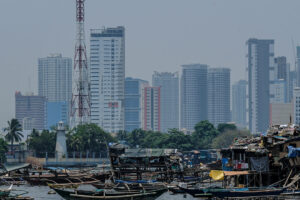PHL told to boost manufacturing jobs to achieve high-income growth
ECONOMISTS flagged the declining employment share of the Philippine manufacturing sector, which they said is key to achieving a high-income status and meeting other development goals including bringing down poverty incidence to single digits at a faster rate.

By Kyle Aristophere T. Atienza, Reporter
ECONOMISTS flagged the declining employment share of the Philippine manufacturing sector, which they said is key to achieving a high-income status and meeting other development goals including bringing down poverty incidence to single digits at a faster rate.
A De La Salle University (DLSU) School of Economics report on Monday showed that most targets under the Philippines’ development plan for 2023 to 2028 will be met later than expected, and noted that the country would struggle to achieve high growth in the long-run in the absence of an industrial policy that has helped its Southeast Asian neighbors’ manufacturing industries climb the value chain.
Most Filipino workers are employed in sectors of “very low productivity,” the report said, adding the manufacturing sector’s employment share is only 8% and is expected to further decrease to 7% by 2030.
“Historically, countries that have achieved high-income status obtained employment shares in manufacturing from about 20-25%, sometimes even higher,” Mariel Monica Sauler, an economics professor at DLSU, said at the report’s launch in Makati City. “Our current manufacturing employment share is just 8%.”
For the Philippines to become an economic powerhouse, it needs to restructure its economy by taking workers out of the agriculture sector through mechanization and by significantly increasing the employment share of its manufacturing base, said Jesus Felipe, director of the Angelo King Institute for Economic and Business Studies at DLSU.
“We desperately need firms with high organizational capabilities and highly productive, that manufacture and export complex products, and that compete in the world economy,” he said during the event.
Mr. Felipe said the declining number of Filipinos leaving the country for job opportunities abroad — a phenomenon linked to an increase in wage rates locally — provides an opportunity for the country to expand its manufacturing base.
According to the report, the number of overseas Filipino workers (OFWs) will further decline to 1.91 million in 2025 from 1.97 million in 2023.
“We think that our wage rates are going to increase. Therefore, the incentive to leave the country declines,” Mr. Felipe said.
Even as the agriculture sector’s employment share has been on a decline, Ms. Sauler said the share of construction and transport and storage sectors, which have “low productivity” and “low wages,” have increased.
This means there are not enough manufacturing jobs locally, she added.
“Our ASEAN (Association of Southeast Asian Nations) neighbors seem to have always understood the importance of the manufacturing sector better than us.”
The economists said the government should shift its focus away from the agriculture sector, which “needs a solution but is not the solution” to the Philippines’ growth woes.
Achieving an upper middle-income status next year would not be possible if the Philippines’ economic expansion would be slower than expected, they said.
BELOW TARGETS
The DLSU report said the Philippine economy will likely hit 5.5-5.6% growth this year, lower than the government’s 6-7% target.
Under the Philippine Development Plan (PDP) 2023-2028, gross domestic product (GDP) annual growth target is set at 6.5-8% until 2028. However, the DLSU report said GDP growth is likely to be “below target until 2028.”
The Philippines is projected to hit its goal of having a gross national income (GNI) per capita of $6,044-$6,571 by 2029, instead of 2028.
According to the World Bank’s latest income classification data, the Philippines remained a lower-middle income country with a GNI per capita of $4,230 in 2023. To become an upper middle-income country, the Philippines now needs to have GNI per capita of $4,516 to $14,005.
Ms. Sauler said that while the Philippines could reach an upper middle-income status as early as this year, its real GDP will grow below the PDP 2023-2028 target rates.
“If we want to expedite development, the structure of the economy will need to change in the direction of industrialization,” she said. “Repeating the industrialization experience of our East Asian neighbors seems impossible but there is no other option.”
Mr. Felipe said the country needs an “industrial policy” centered on the creation of competitive firms that make high-quality products and jobs that require high skills.
While the number of middle-class Filipinos was increasing, Mr. Felipe said a huge chunk of them or 80% of Filipino workers were earning P15,000 per month at most.
“Only 15% of Filipino workers earned above P15,000. This is the reality of the country. This is the distribution of the structural economy from the point of view of output and from the point of view of employment,” he said.
The manufacturing sector accounted for 18% of the Philippine economy last year, while its employment share was only at 7.3%, he noted.
Mr. Felipe said Asian countries that have pursued the path of industrialization have overtaken the Philippines in terms of GNI per capita.
The GNI per capita of the Philippines is still $4,000, which means the country is “among the poorest countries in the world,” he said.
“All our neighbors have systematically, automatically caught up with us and overtaken us,” he said, citing Vietnam, whose GNI per capita was about eight times lower than that of the Philippines in the 1990s.
“Indonesia overtook the Philippines in about 2008 or 2009,” he added. “The same thing happened with China, and the same thing happened with Thailand. Malaysia has always been richer than the Philippines.”
‘UNNECESSARY’
At the same time, the DLSU report estimated the Philippines will only achieve its PDP target of a 3% deficit-to-GDP ratio by 2031, and the debt-to-GDP ratio of 48-53% by 2032.
Pedro Pascual, head of the Economic and Trade Office of Spain in Manila, said the Marcos administration’s fiscal consolidation plan is both “unnecessary” and ill-suited” in the current situation, which is marked by low GDP growth.
The government needs to run a larger budget deficit to build infrastructure needed to revamp its economy, he said.
Mr. Pascual noted that household spending remains subdued, as seen in the declining number of Filipinos traveling abroad for leisure.
Real wages had not fully recovered in 2023 to the pre-pandemic level due partly to inflation, he said. “They will in 2024 to 2025.”
But inflation should not be a major economic concern for the country since it’s mainly driven by rice prices, Mr. Pascual said, adding that it’s up to the government how it will lessen the country’s dependence on or find alternatives for the commodity.
Rice inflation eased for the straight month in June to 22.5% from 23% a month earlier.
“Overambitious disinflation can create a problem,” he added.
The DLSU report also projected that poverty incidence will likely go down to 8.8-9% only by 2035, instead of 2028.
The unemployment rate will settle within the 4-5% target range by 2028, the report showed.

















